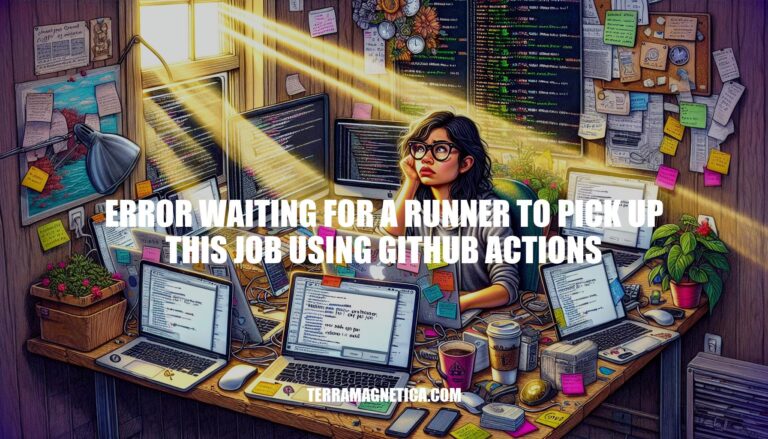The error “waiting for a runner to pick up this job” in GitHub Actions typically occurs when there are no available runners to execute the workflow. This can happen due to high demand on GitHub-hosted runners, misconfiguration in the workflow file, or issues with self-hosted runners. This error delays the execution of automated tasks, impacting the efficiency and reliability of continuous integration and deployment pipelines.
Common Causes
Here are the common causes of the “error waiting for a runner to pick up this job” in GitHub Actions:
Potential Misconfigurations
- Typo in
runs-on Definition: Ensure the runner label is correctly specified (e.g., ubuntu-latest instead of ubuntu:latest or ubuntu-lates).
- Incorrect Workflow File: Errors in the YAML syntax or incorrect job definitions can prevent the runner from picking up the job.
Runner Availability Issues
- Busy Runners: If all available runners are occupied, the job will remain queued until a runner becomes free.
- Self-Hosted Runner Issues: Self-hosted runners might not pick up jobs if they are not correctly configured or if they are offline.
Other Frequent Triggers
- High Load on GitHub-Hosted Runners: During peak times, GitHub-hosted runners might experience high load, causing delays.
- Version Mismatch: If a new runner is added after queuing a job and it’s not the latest version, it might not pick up the job.
If you encounter this error, double-check your workflow configuration and ensure your runners are correctly set up and available.
: GitHub Community Discussion
: GitHub Community Discussion
: GitHub Actions Runner Issue
: Stack Overflow Discussion
Troubleshooting Steps
Sure, here are the troubleshooting steps to resolve the “error waiting for a runner to pick up this job” in GitHub Actions:
-
Check Runner Availability:
- Ensure that there are available runners to pick up the job. If all runners are busy, the job will remain queued.
-
Verify Workflow Configuration:
- Check the
runs-on key in your workflow file to ensure it specifies a valid runner. For example, use ubuntu-latest instead of ubuntu:latest.
-
Inspect Runner Status:
- Go to the Actions tab in your repository and check the status of your runners. Ensure they are online and not experiencing high load.
-
Update Self-Hosted Runners:
- If using self-hosted runners, ensure they are updated to the latest version. Older versions might not pick up jobs correctly.
-
Check GitHub Status:
- Visit the GitHub Status page to see if there are any ongoing issues with GitHub Actions.
-
Review Workflow Logs:
- Look at the logs for any errors or warnings that might indicate why the runner is not picking up the job.
-
Retry the Job:
- Cancel the current job and trigger it again. Sometimes, re-running the job can resolve transient issues.
-
Submit a Bug Report:
- If the issue persists, consider submitting a bug report to GitHub Support with details of your workflow configuration and the error message.
Following these steps should help you identify and fix the underlying issues causing the error.
Best Practices
Here are some best practices to avoid encountering the “error waiting for a runner to pick up this job” in GitHub Actions:
Configuration
- Correct
runs-on Syntax: Ensure the runs-on key in your workflow YAML file is correctly specified. For example, use ubuntu-latest instead of ubuntu:latest.
- Supported OS Versions: Regularly check GitHub’s supported operating systems and update your workflows accordingly.
Runner Management
- Self-Hosted Runners: If using self-hosted runners, ensure they are properly configured and have the necessary permissions and network settings.
- Runner Availability: Monitor the availability of your runners. Use tools like GitHub’s runner management APIs to automate the scaling of runners based on demand.
Workflow Optimization
- Job Queues: Avoid long job queues by optimizing your workflows. Split large workflows into smaller, parallel jobs to reduce wait times.
- Caching: Use caching strategies to speed up job execution. For example, cache dependencies to avoid re-installing them in every run.
- Scheduled Runs: Schedule non-critical workflows during off-peak hours to reduce competition for runners.
Implementing these practices can help ensure smoother and more efficient GitHub Actions workflows.
The “error waiting for a runner to pick up this job” in GitHub Actions
occurs when there are no available runners to execute the workflow, often due to high demand on GitHub-hosted runners, misconfiguration, or issues with self-hosted runners.
To resolve this error:
- Check runner availability
- Verify workflow configuration
- Inspect runner status
- Update self-hosted runners
- Review workflow logs
Best practices include:
- Correct runs-on syntax
- Supported OS versions
- Proper self-hosted runner configuration
- Monitoring runner availability
- Job queue optimization
- Caching
- Scheduled runs


